3. Network Protection Requirements
3.1 General
3.1.1 Laboratory Environment
All tests to determine conformity with this specification shall be conducted in a laboratory environment at normal room temperature and humidity.
3.2 For Future Use
Reserved for future use.
3.3 Extraneous AC Energy
3.3.1 Metallic AC Energy
The power delivered into a 2-wire loop simulator circuit or into the transmit and receive pairs of a 4-wire loop simulator or into a 600 Ω termination (where appropriate) in the on-hook state, by loop-start or ground-start equipment, shall not exceed -55 dBm within the frequency band from 200 Hz to 3995 Hz. Network protective circuitry shall also ensure that, for any input level up to 10 dB above the overload point, the power to a 2-wire loop simulator circuit or the transmit and receive pairs of a 4-wire loop simulator circuit or into a 600 Ω termination (where appropriate) does not exceed the above limits.
3.3.1.1 Method of Measurement
- Connect the terminal equipment (TE) to the test circuit as shown in Figure 3.3.1.1.
- Set the filter to obtain a 200 Hz to 3995 Hz band and arrange the true r.m.s. voltmeter in dBm to read power averaged over three seconds.
- Verify that the signal level is less than the limit.
Figure 3.3.1.1 — Metallic AC Signal Measurement
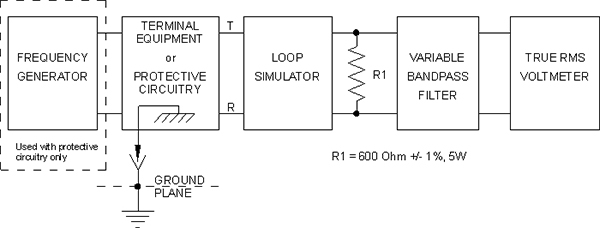
Note: When the TE makes provision for an external connection to ground (G), the TE shall be connected to ground. When the TE makes no provision for an external ground, the TE shall be placed on a ground plane which is connected to ground and has overall dimensions at least 50% greater than the corresponding dimensions of the TE. The TE shall be centrally located on the ground plane without any additional connection to ground. At no point in time should any metal surface of the TE come in contact with the ground plane. If the TE has exposed metal that could come in contact with the metal ground plane, a thin insulating material shall be inserted between the ground plane and the TE.
3.3.2 Longitudinal AC Signals
3.3.2.1 Longitudinal Voltage in the 100 Hz to 4 kHz Range
The weighted r.m.s. voltage (see Note in Section 3.3.2.2) averaged over 100 ms resulting from all of the component longitudinal voltages in the 100 Hz to 4 kHz band after weighting according to the transfer function of F/4000, where F is the frequency in hertz, shall not exceed the maximum indicated in Table 3.3.2.1.
| Frequency Range | Maximum r.m.s. Voltage | Impedance |
|---|---|---|
| 100 Hz to 4 kHz | −30 dBV | 500 Ω |
3.3.2.2 Longitudinal Voltage in the 4 kHz to 270 kHz Range
The r.m.s. value of the longitudinal voltage component in the specified frequency bands shall not exceed the limits given in Table 3.3.2.2.
| Centre Frequency (f) of 8 kHz Band | Max. Voltage (see Note) in all 8 kHz Bands | Longitudinal Terminating Impedance |
|---|---|---|
| 8 kHz to 12 kHz | −(18.4+20 log f) dBV | 500 Ω |
| 12 kHz to 42 kHz | (3−40 log f) dBV | 90 Ω |
| 42 kHz to 266 kHz | −62 dBV | 90 Ω |
| Note: Average magnitudes may be used for signals that have peak-to-r.m.s. ratios of 20 dB and less. If the peak-to-r.m.s. ratio of the interfering signal exceeds this value, the r.m.s. limitations must be used instead of average values. | ||
3.3.2.3 Longitudinal Voltage in the 270 kHz to 6 MHz Range
The r.m.s. value of the longitudinal voltage components in the frequency range of 270 kHz to 6 MHz shall not exceed −30 dBV. This requirement applies to longitudinal termination impedance of 90Ω.
3.3.2.4 Method of Measurement (Longitudinal)
- If the TE has analog interfaces with through transmission from digital interfaces, connect the TE as shown in Figure 1.5.2.
- Connect the TE to the test circuit as shown in Figure 3.3.2.4. Place the TE in the on-hook state.
- For multiple network interfaces, including TE with two or more interfaces (e.g. two-line telephone sets, as well as key telephone systems (KTS), PBX, etc.), the following applies:
- One of the interfaces not under test shall be put in the off-hook state.
- One of the interfaces not under test shall have a continuous ringing signal applied. TE with two or more network interfaces, one interface not under test shall have a 130 V continuous ringing signal applied during the testing of the other interface(s).
- One of the interfaces not under test shall be placed on hold (including audio input-on-hold, if provided).
- Set the resistance value to R1 = R2 = 300 Ω, and R3 = 350 Ω.
- With S1 in position "a", arrange the true r.m.s. voltmeter to read the voltage in dBV in the 100 Hz to 4 kHz band. The weighting network shall have a transfer function of F/4000, where F is the frequency in Hz.
- Record the voltmeter reading and add a +3.1 dB correction factor to the measurement value.
- Change the resistance values to R1 = R2 = 150 Ω, and R3 = 425 Ω.
- Change S1 to position "b" and, using either a spectrum analyzer or an r.m.s. voltmeter and appropriate filters, measure the signal level in the 4 kHz to 12 kHz band. Add +1.4 dB to the measured value to compensate for the longitudinal termination.
- Change the resistance values to R1 = R2 = 67.5 Ω, and R3 = 56.3 Ω.
- Using either a spectrum analyzer or an r.m.s. voltmeter and filter, set the bandwidth to 8 kHz, sweep the 12 kHz to 270 kHz band and record the results. Add a correction factor of +4 dB to the results to compensate for the difference between the point of measurement and the actual longitudinal impedance. (See note below).
Note:
If the spectrum analyzer has no 8 kHz bandwidth setting, a 10 kHz bandwidth may be used. However, it will be necessary to apply a −1 dB correction factor, or make additional measurements, or both, to compensate for the wider bandwidth being used.
- Compare the results with the allowed limits. (See note below).
Note:
If a 10 kHz bandwidth is used and a failure condition is noted, it may be necessary to check that reading using a higher resolution if the spectral content had an uneven distribution. The total r.m.s. voltage over an 8 kHz band can be calculated by the following expression:
Vt = (V12 + V2 2 + V32 + ........ Vn2) ½
- where:
- Vt is total r.m.s. voltage over any 8 kHz band; and
- V1, V2, V3, ... Vn are the spectral components within that band.
- If the spectral content of a band is evenly distributed, then the equivalent r.m.s. power in an 8 kHz band can be found by subtracting 1 dB from the measured power using a 10 kHz bandwidth.
- With S1 in position "c" and the bandpass filter arranged to pass the 270 kHz to 6 MHz band, measure the peak voltage. Multiply the peak voltage by 0.707 to obtain the r.m.s. voltage.
- For registered TE or protective circuits with provision for through transmission from other equipment, apply one of the following excitation signals (as applicable for the off-hook state):
- a 1004 Hz signal that results in a power output of -13 dBm delivered into a 600 Ω load at the network interface;
or - a standard signal or bit stream, simulating normal use of a given type of TE.
- a 1004 Hz signal that results in a power output of -13 dBm delivered into a 600 Ω load at the network interface;
- Place the TE in an off-hook state. For loop-start and ground-start trunk interfaces, adjust the DC feed to provide a current equal to the value recorded in step (4) of Section 3.5.2.2. Repeat steps (4) to (13).
- Place the TE in an off-hook state. Adjust the DC feed to provide a current of 70 mA (or maximum current, whichever is less). Repeat steps (4) to (12).
Figure 3.3.2.4 — Longitudinal Signal Power Measurement Method
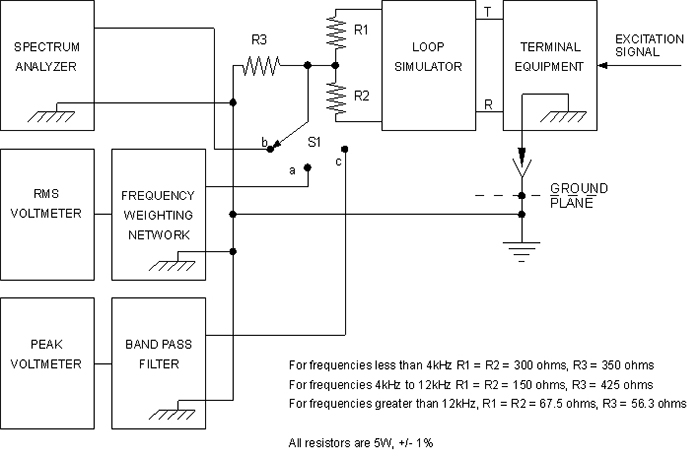
Note: When the TE makes provision for an external connection to ground (G), the TE shall be connected to ground. When the TE makes no provision for an external ground, the TE shall be placed on a ground plane which is connected to ground and has overall dimensions at least 50% greater than the corresponding dimensions of the TE. The TE shall be centrally located on the ground plane without any additional connection to ground. At no point in time should any metal surface of the TE come in contact with the ground plane. If the TE has exposed metal that could come in contact with the metal ground plane, a thin insulating material shall be inserted between the ground plane and the TE.
3.4 Transmitted Signal Power
3.4.1 In-band Transmitted Signal Power — Metallic
- The power of all signal energy in the frequency band from 200 Hz to 3995 Hz, delivered by the TE or network protection device to the appropriate simulator (other than non-permissive data equipment or data protective circuitry), shall not exceed -9 dBm when averaged over any three-second interval.
- For 2-wire and 4-wire lossless tie trunk interfaces, the maximum power of other than live voice signals, delivered to a 600 Ω termination, shall not exceed -11 dBm when averaged over any three second interval.
- For OPS lines, the maximum power delivered to an OPS line simulator circuit shall not exceed -9 dB with respect to one milliwatt (mW) when averaged over any three-second interval.
- For test equipment, the maximum signal power delivered to a loop simulator circuit shall not exceed 0 dBm when averaged over any three-second interval.
- For voice band private lines using ringdown or in-band signalling, the maximum power of other than live voice signals delivered to a 600 Ω termination shall not exceed -13 dBm when averaged over any three-second interval.
- For voice band private lines using in-band signalling in the band 2600 ± 150 Hz, the maximum power delivered to a 600 Ω termination shall not exceed -8 dBm during the signalling mode. The maximum power delivered to a 600 Ω termination in the on-hook steady state supervisory condition shall not exceed -20 dBm. The maximum power of other than live voice signals delivered to a 600 Ω termination during the non-signalling mode and for other in-band systems shall not exceed -13 dBm when averaged over any three-second interval.
3.4.1.1 Method of Measurement (Voice and Data Circuit TE)
3.4.1.1.1 Voice TE
The voice TE shall be tested as specified in Section 3.4.1.1.3 for any of the following message sources:
- Pre-recorded voice signals as described in Section 3.4.9.1.
- Messages stored permanently within the TE by the manufacturer.
- Messages recorded from the telephone network which can be transmitted back to the network.
- Tone signals originating within the TE.
3.4.1.1.2 Data Circuit TE
The data circuit TE shall be tested as specified in Section 3.4.1.1.3. Where the equipment is designed to operate in response to an external signal (electrical, optical or mechanical), the input signal shall be appropriate for the equipment being tested and shall simulate the worst case that may normally be expected.
3.4.1.1.3 Method of Measurement
- Connect the TE to the test circuit as shown in figures 3.4.1.1.3(a) through to 3.4.1.1.3(c).
- Operate the DC feed and ring-up circuit to bring the TE to the off-hook state and apply 70 mA (or maximum current, whichever is less).
- Set the filter cut-off frequencies to achieve a 100 Hz to 4000 Hz bandpass and arrange the voltmeters to read power in dBm averaged over three seconds.
- Operate the TE at maximum gain to transmit each of its possible output signals. Where data circuit TE is provided with external or programmable gain control, operate these controls to provide maximum gain for each of its possible signals.
- Record the maximum power level reading in dBm at minimum and maximum loop currents attainable with the loop simulator, if applicable.
- Repeat steps (4) and (5) for other operating states, if applicable.
Note:
When data circuit TE is intended to operate with programming resistors for signal level control, the values of the programmed levels given in Table 3.4.3 shall be verified.
Figure 3.4.1.1.3(a) — Transmitted Signal Power Measurement, 2-Wire
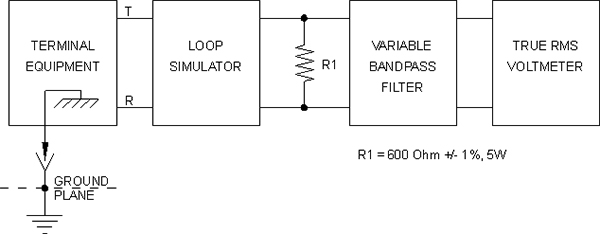
Notes:
- When the TE makes provisions for an external connection to ground (G), the TE shall be connected to ground. When the TE makes no provision for an external ground, the TE shall be placed on a ground plane which is connected to ground and has overall dimensions at least 50% greater than the corresponding dimensions of the TE. The TE shall be centrally located on the ground plane without any additional connection to ground. At no point in time should any metal surface of the TE come in contact with the ground plane. If the TE has exposed metal that could come in contact with the metal ground plane, a thin insulating material shall be inserted between the ground plane and the TE.
- Select the appropriate loop simulator for the interface of the terminal equipment.
Figure 3.4.1.1.3(b) — Transmitted Signal Power Measurement, 4-Wire

Notes:
- When the TE makes provisions for an external connection to ground (G), the TE shall be connected to ground. When the TE makes no provision for an external ground, the TE shall be placed on a ground plane which is connected to ground and has overall dimensions at least 50% greater than the corresponding dimensions of the TE. The TE shall be centrally located on the ground plane without any additional connection to ground. At no point in time should any metal surface of the TE come in contact with the ground plane. If the TE has exposed metal that could come in contact with the metal ground plane, a thin insulating material shall be inserted between the ground plane and the TE.
- Select the appropriate loop simulator for the interface of the TE.
Figure 3.4.1.1.3(c) — Transmitted Signal Power Measurement, E&M Tie
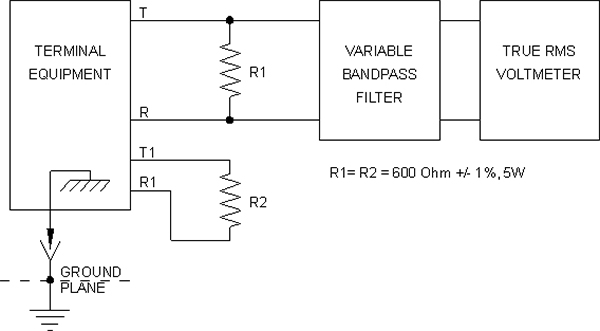
The figure shown is for a 4-wire interface; for 2-wire interface, the T1 and R1 are not present.
Notes:
- When the TE makes provisions for an external connection to ground (G), the TE shall be connected to ground. When the TE makes no provision for an external ground, the TE shall be placed on a ground plane which is connected to ground and has overall dimensions at least 50% greater than the corresponding dimensions of the TE. The TE shall be centrally located on the ground plane without any additional connection to ground. At no point in time should any metal surface of the TE come in contact with the ground plane. If the TE has exposed metal that could come in contact with the metal ground plane, a thin insulating material shall be inserted between the ground plane and the TE.
- Select the appropriate loop simulator for the TE interface.
3.4.2 Limitations on Internal Signal Sources, Primarily Intended for Network Control Signalling, Contained in Voice and Data Equipment
- For all operating conditions of the TE, except tie trunk applications, the maximum power in the frequency band below 3995 Hz delivered to a loop simulator circuit shall not exceed the following levels when averaged over any three-second interval:
- 0 dBm when DTMF is used for network control;
- 0 dBm when DTMF is used for end-to-end signalling via manual entry of a keypad or repertory dialler. The term "repertory dialler" does not accommodate devices capable of generating more than 40 DTMF digits per manual keystroke;
- −9 dBm in all other cases.
- For tie trunk applications, the maximum power delivered to a 600 Ω termination for TE under all operating conditions shall not exceed −4 dBm over any three-second interval.
3.4.2.1 Method of Measurement
Refer to the test method given in Section 3.4.1.1.
3.4.3 Requirements for Data Circuit TE
Data circuit TE intended for electrical connection to a network interface shall not transmit r.m.s. signal power, in the 200 Hz to 3995 Hz frequency band that exceeds 0 dBm, when averaged over any three-second interval. The following additional special case requirements shall take precedence over the general requirement. Data circuit TE shall be capable of operating in at least one of the states discussed in (1), (2), or (3) below. The output power level of the data circuit TE shall not be easily alterable by the end user to levels that exceed the signal power limits specified herein.
- Data circuit TE intended to operate with a programming resistor for signal level control shall not exceed the programmed levels provided in Table 3.4.3.
- Data circuit TE intended to be acoustically coupled to the network or intended to connect electrically via a voice-type miniature 6-position plug, shall not transmit signals from 200 Hz to 3995 Hz that exceed −9 dBm when averaged over any three-second interval.
- Data circuit TE intended to operate in the fixed loss loop (FLL) state shall not transmit signal power that exceeds −4 dBm in the 200 Hz to 3995 Hz frequency band when averaged over any three-second interval.
Note:
Limits on signal power shall be satisfied at the interface for all 2-wire network ports and, where applicable to offered services, both transmit and receive pairs of all 4-wire network ports. Signal power measurements shall be made using the terminations specified in each of the following limitations. The transmit and receive pairs for 4-wire network ports shall be measured with the pair not under test, connected to a termination equivalent to that specified for the pair under test. Through-gain limitations apply only in the direction of transmission toward the network.
Voice band signal power requirements for analog interfaces apply to the 200 Hz to 3995 Hz band.
| Programming Resistor (Rp) Footnote * | Programmed Data Equipment Signal Power Output Footnote ** |
|---|---|
| Short circuit | 0 dBm |
| 150 Ω | −1 dBm |
| 336 Ω | −2 dBm |
| 569 Ω | −3 dBm |
| 866 Ω | −4 dBm |
| 1240 Ω | −5 dBm |
| 1780 Ω | −6 dBm |
| 2520 Ω | −7 dBm |
| 3610 Ω | −8 dBm |
| 5490 Ω | −9 dBm |
| 9200 Ω | −10 dBm |
| 19800 Ω | −11 dBm |
| Open circuit | −12 dBm |
Footnotes
- Footnote 1
Tolerance of Rp is + 1%
- Footnote 2
Tolerance of programmed data jack signal power output is + 1 dB. These values shall be averaged over any three-second interval.
3.4.3.1 Method of Measurement
- Connect the TE to the test circuit as shown in Figure 3.4.3.1.
- Operate the DC feed and ring up circuit to bring the TE off-hook and apply 70 mA (or maximum current, whichever is less).
- Set the filter cut-off frequencies to achieve a 100 Hz to 4000 Hz bandpass and arrange the voltmeters to read power in dBm averaged over three seconds.
- Operate the TE with a short between the PR and PC port.
- Record the maximum power level reading in dBm at minimum and maximum loop currents attainable with the loop simulator, if applicable.
- Repeat step (5) with all other programmable resistor (Rp) values in Table 3.4.3, if applicable.
Figure 3.4.3.1 — Transmitted Signal Power Measurement With Programming Resistor
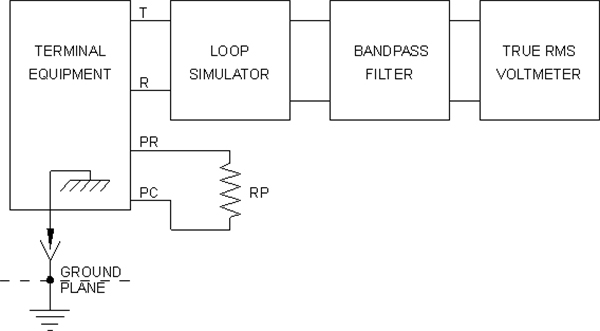
Notes:
- For programmed data equipment, measurements should be made with the value of the programming resistor (RP) set for each of the following values: short circuit, 150 Ω, 336 Ω, 569 Ω, 866 Ω, 1240 Ω, 1780 Ω, 2520 Ω, 3610 Ω, 5490 Ω, 9200 Ω, 19800 Ω, and open circuit.
- When the TE makes provisions for an external connection to ground (G), the TE shall be connected to ground. When the TE makes no provision for an external ground, the TE shall be placed on a ground plane which is connected to ground and has overall dimensions at least 50% greater than the corresponding dimensions of the TE. The TE shall be centrally located on the ground plane without any additional connection to ground. At no point in time should any metal surface of the TE come in contact with the ground plane. If the TE has exposed metal that could come in contact with the metal ground plane, a thin insulating material shall be inserted between the ground plane and the TE.
